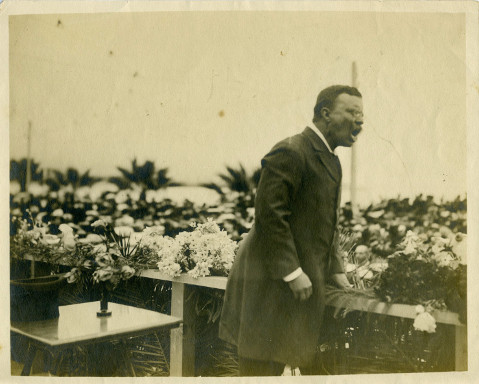Theodore Roosevelt Visits Santa Barbara
Exciting Times for the City in 1903

Presidents have been not been strangers to Santa Barbara. Benjamin Harrison was the first chief executive to visit, receiving a tumultuous welcome in 1891. Others have included William McKinley, Bill Clinton, and, of course, Ronald Reagan, who had a ranch near Refugio. Others visited before becoming president, including Herbert Hoover and Richard Nixon.
Theodore Roosevelt’s visit in May 1903 caused great excitement. Roosevelt had been president for less than two years, inheriting the job when an assassin felled William McKinley.

At 11 a.m. on May 9, Roosevelt’s train pulled up to Montecito’s depot on Olive Mill Road. A group of local dignitaries, including Santa Barbara mayor George S. Edwards, and a large crowd were on hand to greet him. Fittingly, given Roosevelt’s interest in conservation, his mounted escort consisted of rangers from the nearby national forest, now known as Los Padres National Forest.
The long line of carriages started out for Santa Barbara. Despite heavy fog, Roosevelt expressed delight at the scenery; it was the first time he had laid eyes on the Pacific Ocean. The procession ended at Plaza del Mar, about where Pershing Park’s band shell is today.
A huge crowd, including over a thousand schoolchildren let out of class for the special event, surrounded a large speaker’s platform. Among those on the platform with the President were California governor George C. Pardee, the Secretary of the Navy, and the presidents of Columbia University and the University of California. Local representatives of the Grand Army of the Republic, Santa Barbara’s own Naval Reserve Division, and trainees from the U.S. Navy ship Alert were all in attendance. As the President prepared to address the crowd, the Alert, anchored offshore, fired her guns in salute. Roosevelt was introduced to Julia Williams, a guest of honor on the platform, who had been the sole keeper of the Santa Barbara lighthouse since 1865 and would continue in that capacity until her retirement in 1905.
After Roosevelt’s rousing speech, the procession moved up State Street, thronged with hundreds of additional well-wishers, and then over to the Old Mission. After a tour of the mission and its grounds, Roosevelt delivered another stirring speech, this time addressing the need to conserve the nation’s natural resources.
The trip back to town and to the Victoria Street train depot was interrupted at the corner of Pedregosa and Laguna streets. There, Roosevelt climbed down from his carriage to pay his respects to Mrs. W. W. Hollister, who was staying at the home of her daughter, Jennie Hale. Mrs. Hollister’s son, Stanley, had served under Roosevelt in the Rough Riders during the Spanish-American War. He had been wounded at San Juan Hill and succumbed to typhoid while recovering in a Virginia hospital.
After visiting with Mrs. Hollister, Roosevelt realized the group would be late for the scheduled departure of 2 p.m. He instructed his driver to move smartly along, and soon the whole group was making a mad dash for the depot, with some members of the mounted escort taking to the sidewalks to keep pace. The train pulled out right on time, and with this rather dramatic exit, Teddy Roosevelt’s visit to Santa Barbara closed.
Michael Redmon, director of research at the Santa Barbara Historical Museum, will answer your questions about Santa Barbara’s history. Write him c/o The Santa Barbara Independent, 122 West Figueroa Street, Santa Barbara, CA 93101.



